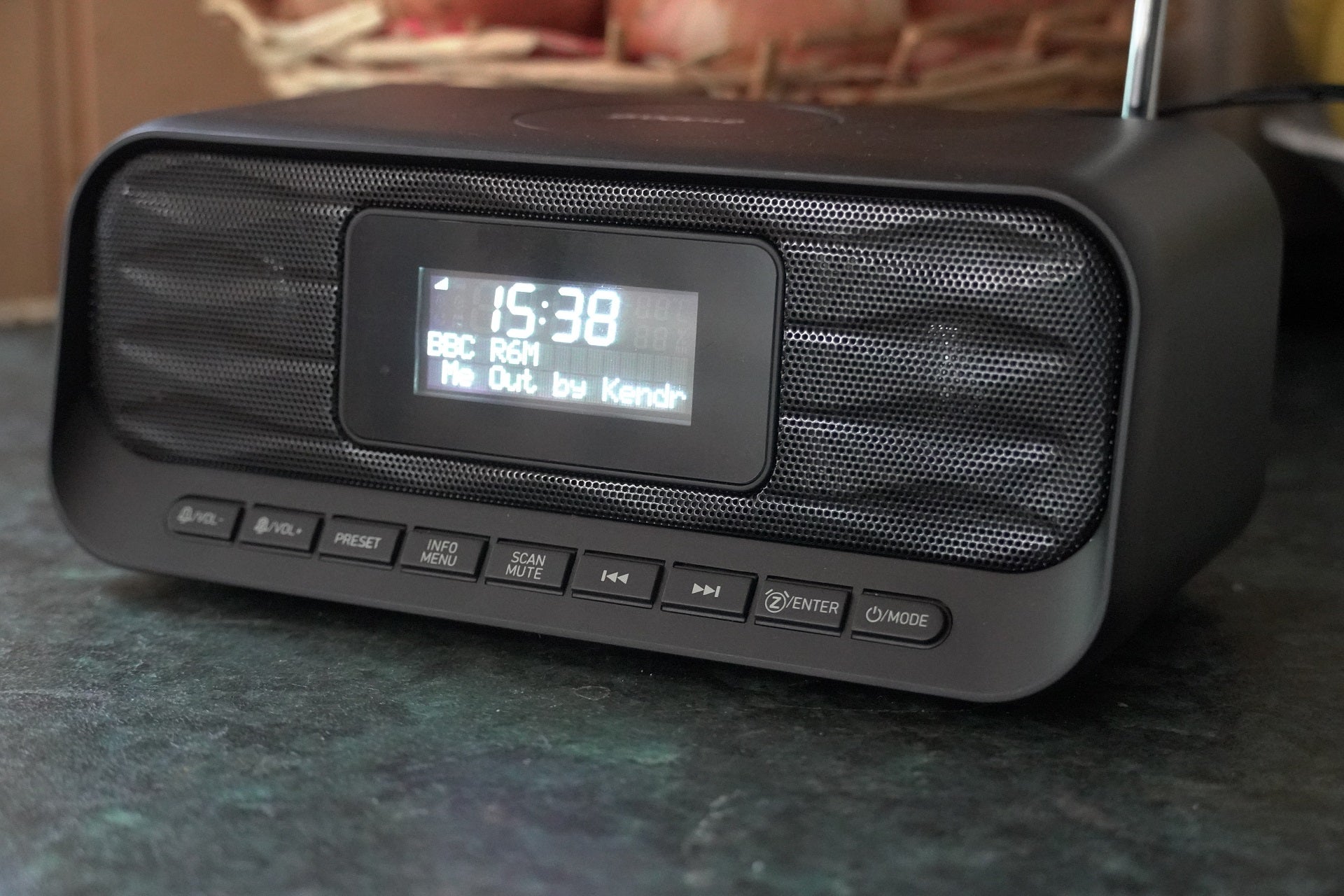Verdict
A solid radio from Groov-e, one that’s easy to use and produces a good performance with broadcast radio, though its wireless charger doesn’t quite hit the claimed performance level.
Pros
- Affordable asking price
- Wireless charging support
- Good audio performance
- Easy to use
Cons
- Unfashionable looks
- Wireless charging skills a little overstated
- Quiet Bluetooth performance at default volume
Availability
- UKRRP: £59.99
- USARRP: $69.99
- EuropeRRP: €69.99
- CanadaTBC
- AustraliaTBC
-
Wireless charging10W wireless charging plate -
Presets30 DAB presets, 30 FM presets -
ConnectivityUSB charging port, 3.5mm input, Bluetooth 5.0
Introduction
Groov-e’s radios are usually named after a place: Venice, Berlin, or Paris but this DAB radio looks to Greek mythology for inspiration, taking its name from the God of the Sky in Zeus.
Quite why it’s called Zeus is not clear at first – perhaps it’s just a cracking name – or maybe it’s something to do with his thunderbolts and the radio’s wireless charging capabilities, but I’m just spitting out guesses.
Its wireless charging skill suggests a radio that’s more feature-packed and versatile than your usual effort, a radio levelling up with the times instead of being rooted in the past. The Zeus is a DAB radio that fits more into your daily routine, but is its performance worthy of sitting on your bedside table?
Design
- Unfashionable looks
- Readable LCD display
- Decent build quality
Having reviewed Groov-e’s Venice, the Zeus subscribes to form follows function in terms of aesthetics, but its construction does feel a step up. It’s still lightweight but feels more solid than its stablemate, bigger and wider than the Venice’s profile and therefore taking up more space. Unlike the Venice, the Zeus doesn’t see itself as a portable unit, best suited for tabletop counters or bedside desks.
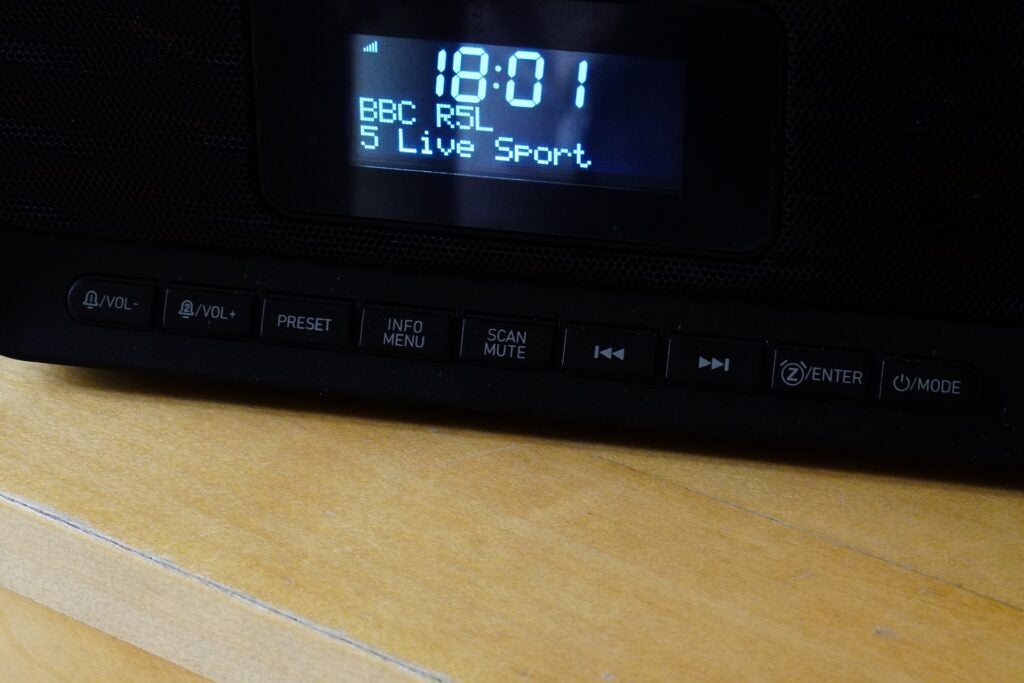
On its front is a small LCD display that’s big and bright enough to see the time, station and scrolling radio text but ideally, you’d want to be closer rather than further away to read the text. The backlight can be adjusted in the menu (High, Med, Low) or a timeout set if you don’t want it shining bright when sleeping, for example.
Around the back is the telescopic aerial, 3.5mm input, USB port for charging a device and the power supply. The Zeus runs off the mains and doesn’t support replaceable batteries.
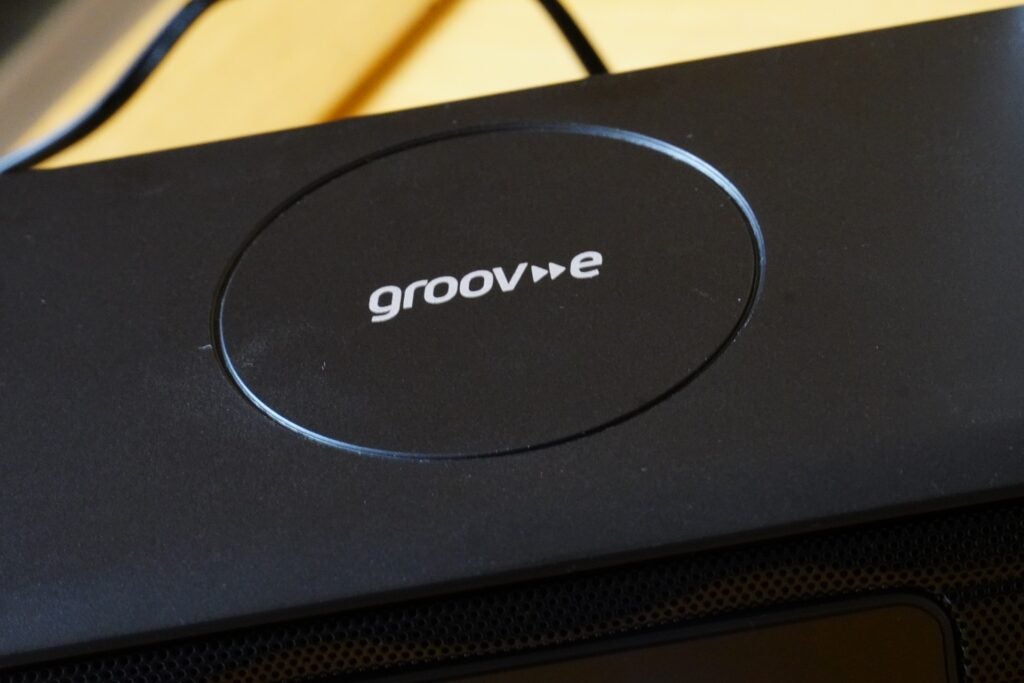
On top is where you’ll find the radio’s wireless charging panel where you can plonk compatible headphones or smartphones. Simply pop it on top and you’ll hear a vibration and it’ll start charging.
Back to the front and the bottom rung of the front are buttons for volume, presets, menu, scanning, navigation, and the ‘Mode’ button that switches between DAB, FM and Bluetooth while a hold switches the speaker on and off.
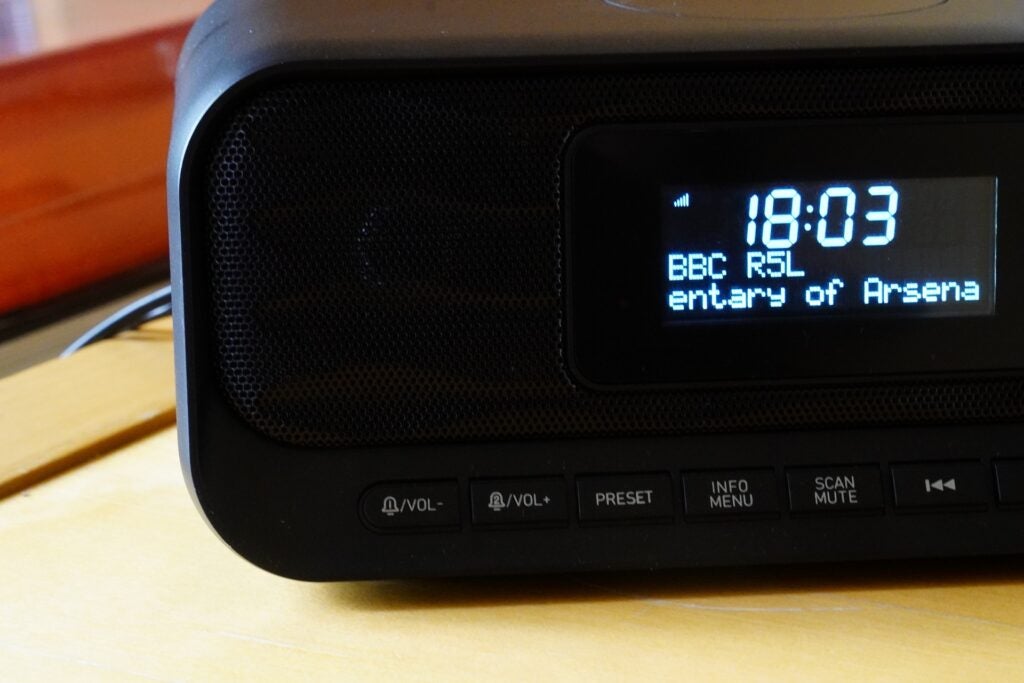
In terms of looks the Zeus is a functional unit, covered in all black, its rounded corners the only real concession to style. Roberts’ Radios are more attractive in this respect if your tastes skew to would be ‘interior decorator’, but there’s little to complain the Groov-e’s unfussy nature.
Features
- Wireless charging
- 60 presets across DAB and FM
- Selection of EQ presets
Like the Venice, the Zeus has DAB, FM and Bluetooth (version 5.0), so you can pair the radio with a mobile device and use it as a speaker. There’s room for a hefty 60 presets – 40 more than the Venice – with 30 each shared between DAB and FM.
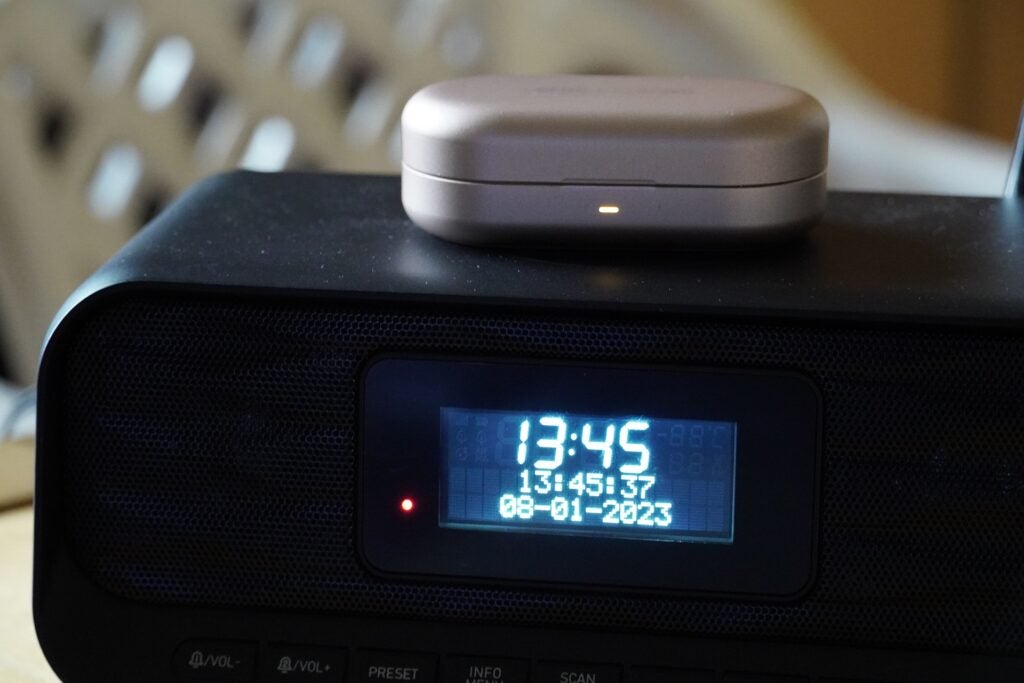
The previously mentioned wireless charger has 10W at its disposal, and using the Amperes Lite Charging Battery app on an iPhone 13 mini that figure works out 5.41W with subsequent attempts in the following days falling to as low as 1.27W, much less than the advertised 10W. 10W is considered enough (and is most common) but you can find wireless charging pads that can transfer up to 15W. It’s better to use the USB port if a device can connect to it.
For alarms there’s the choice of waking up to the tones of the radio springing into life or setting a repeated buzzer, and if you have no intention of getting out of bed then hitting the ‘Snooze’ (Enter) button and you’ll get another wakeup call 9 minutes later. The Sleep timer automatically puts the radio into standby for up to 90 minutes.
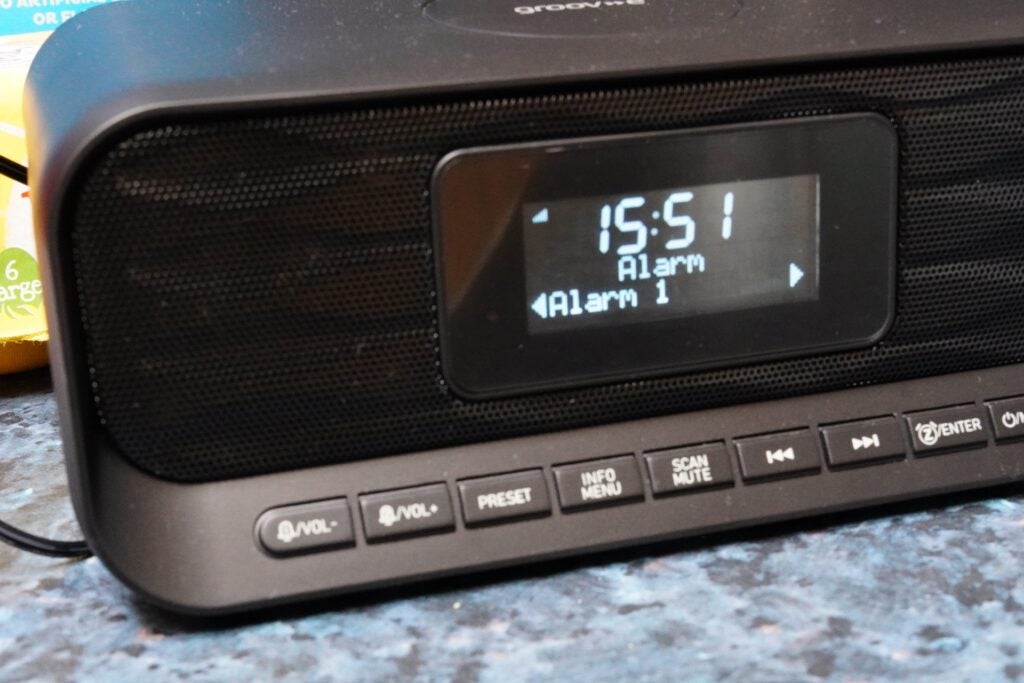
There’s no Dynamic Range Control (DRC) to control highs and lows in radio programmes like there was in the Venice, but there is the choice of EQ presets which include Flat, Normal, Classic, Pop, Jazz and Rock. For some reason the Zeus’ manual also lists Speech and My EQ as an option but they’re not included.
The menu interface is another easy one to grapple with. Hold on the ‘Info/Menu’ button and use the forward and back buttons to navigate; the ‘Enter’ to go deeper with the menus and the ‘Info/Menu’ to ease back out of them. Very simple, very straightforward and minimum fuss or lag.
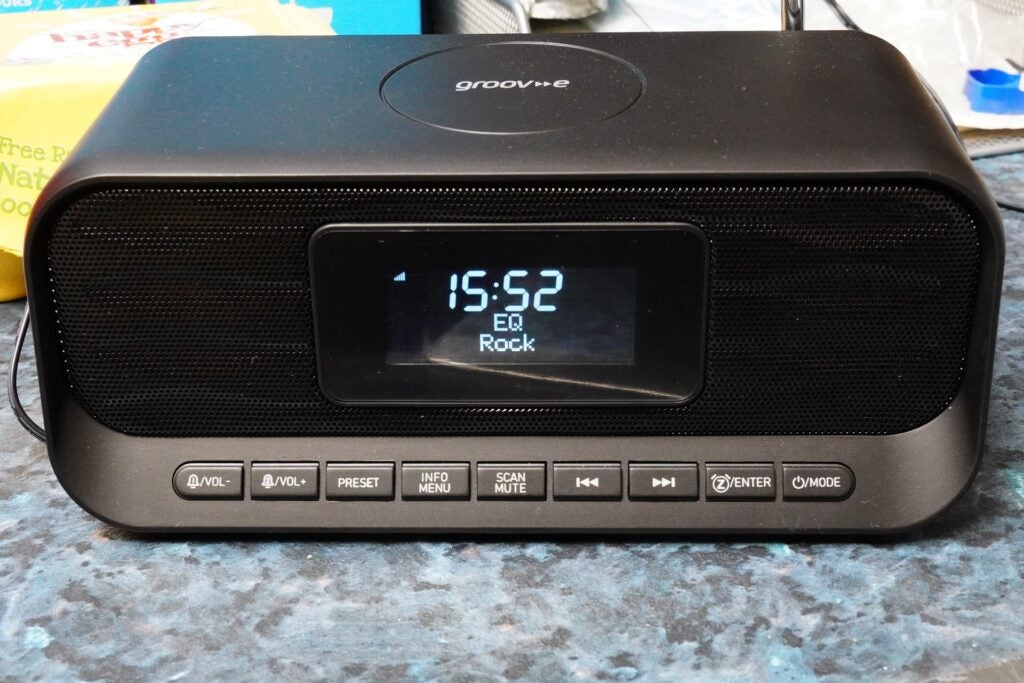
Sound Quality
- Clear, smooth sound
- Slightly clumpy bass performance
- Bluetooth performance quite at default volume
This is an instant step up from Venice in terms of its audio performance. The Zeus is more detailed, clearer, and better balanced across the frequency range. The Venice proved to be much better with spoken word over music, the Zeus is better at both.
Like the Venice the tone is crisper, emphasis is on the treble frequencies to focus on voices. That does open the Zeus to sibilant tones every so often with broadcasts but it’s marginal and I find it counterbalanced by some more oomph to the low frequencies, the Zeus adopts a smoother performance, though the Roberts Zen Plus (£99.99) is a clearer more detailed performer. Nevertheless, the Zeus’ sense of clarity is acceptable enough.
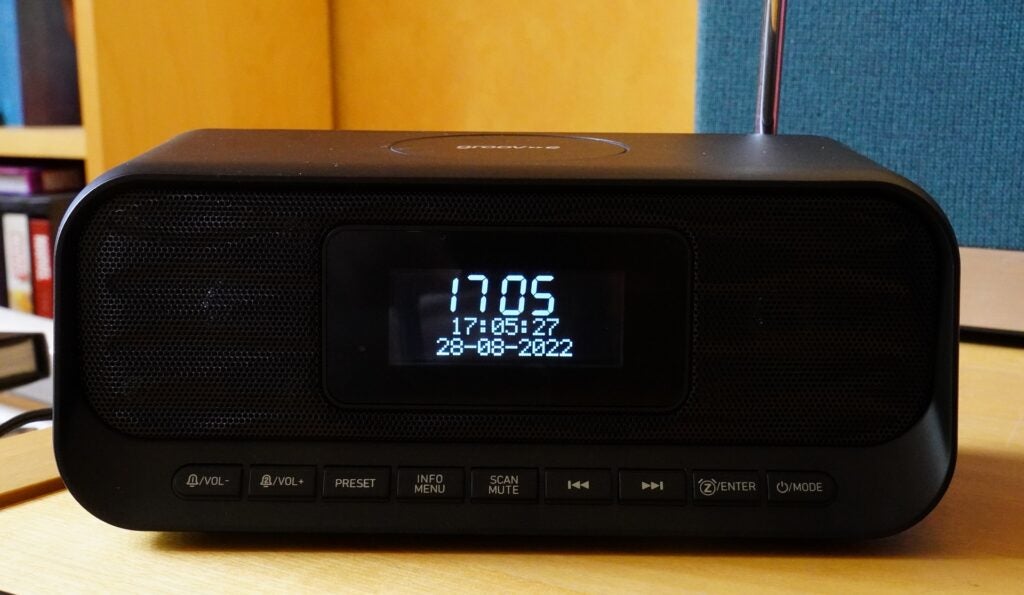
If anything, it’s the mid-bass region that feels a little unclear to my ears, with not quite that clarity and separation evident between midrange and bass listening to music on Radio 6 Music. It leads to bass sounding as if it’s a one-note thud, not really its own separate identity and at times rather inarticulate.
But I can forgive that lack of cohesion given the Zeus treats voices clearly and presents them foremost in the soundstage, and playing with the EQ settings does derive a better performance from the radio. The default Flat EQ is a little charmless, but Normal is louder, more dynamic, and expansive, and both Rock and Jazz add some pep and character to the Zeus’ performance.
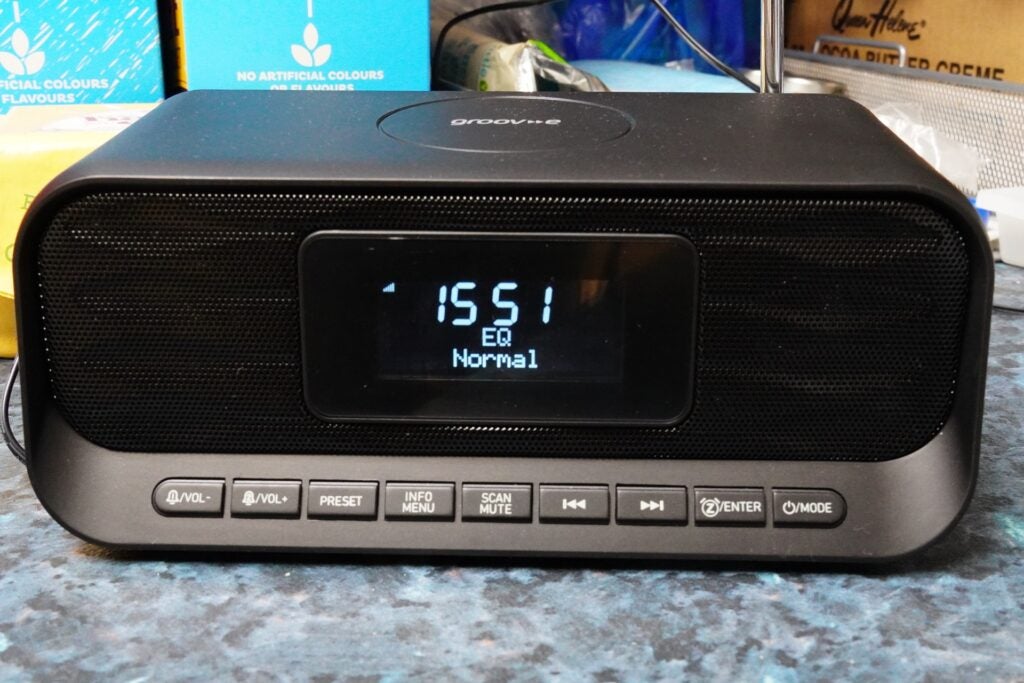
Turn the volume up full whack and there’s some distortion with voices along with a lack of clarity but nothing I’d say is out of ordinary. The crisper, sharper tone does incur more sibilance, the soundstage takes on a cruder tone.
There is Bluetooth playback to consider too but the Groov-e Zeus proves to be a rather timid effort initially, I have to turn the volume up all the way on the radio and nearly all the way on my phone for Outkast’s Ms. Jackson to have any presence. It’s a decent performance but put up against a similarly priced Bluetooth speaker in the Tribit Stormbox Micro 2 doesn’t boast as big a sound but sounds clearer and more detailed.
Latest deals
Should you buy it?
A radio that does more than just broadcast: Though it’s wireless charging powers are a little overstated, the Zeus puts in a respectable overall performance.
You like the convenience of wireless charging: Wireless charging is still no where near as fast as wired charging, but even so, the Zeus’ performance is less than Groov-e’s stated benchmark.
Final Thoughts
Another solid radio from Groov-e, one that’s easy to use and produces a good performance with broadcast radio. The wireless charging doesn’t quite live up to expectations and its Bluetooth performance ought to be a bit stronger out the box but nevertheless, this no-fuss radio is a good bedside partner.
How we test
We test every radio we review thoroughly over an extended period of time. We use industry standard tests to compare features properly. We’ll always tell you what we find. We never, ever, accept money to review a product.
Find out more about how we test in our ethics policy.
Tested over several weeks
Tested with DAB and Bluetooth sources
Battery charging test conducted
FAQs
For iPhones that support wireless charging, the Groov-e Zeus can boost their battery by placing the phone on the charging plate.
Jargon buster
DAB
DAB stands for Digital Audio Broadcasting, and is a digital radio standard use for broadcasting digital services
Verdict
A solid radio from Groov-e, one that’s easy to use and produces a good performance with broadcast radio, though its wireless charger doesn’t quite hit the claimed performance level.
Pros
- Affordable asking price
- Wireless charging support
- Good audio performance
- Easy to use
Cons
- Unfashionable looks
- Wireless charging skills a little overstated
- Quiet Bluetooth performance at default volume
Availability
- UKRRP: £59.99
- USARRP: $69.99
- EuropeRRP: €69.99
- CanadaTBC
- AustraliaTBC
-
Wireless charging10W wireless charging plate -
Presets30 DAB presets, 30 FM presets -
ConnectivityUSB charging port, 3.5mm input, Bluetooth 5.0
Introduction
Groov-e’s radios are usually named after a place: Venice, Berlin, or Paris but this DAB radio looks to Greek mythology for inspiration, taking its name from the God of the Sky in Zeus.
Quite why it’s called Zeus is not clear at first – perhaps it’s just a cracking name – or maybe it’s something to do with his thunderbolts and the radio’s wireless charging capabilities, but I’m just spitting out guesses.
Its wireless charging skill suggests a radio that’s more feature-packed and versatile than your usual effort, a radio levelling up with the times instead of being rooted in the past. The Zeus is a DAB radio that fits more into your daily routine, but is its performance worthy of sitting on your bedside table?
Design
- Unfashionable looks
- Readable LCD display
- Decent build quality
Having reviewed Groov-e’s Venice, the Zeus subscribes to form follows function in terms of aesthetics, but its construction does feel a step up. It’s still lightweight but feels more solid than its stablemate, bigger and wider than the Venice’s profile and therefore taking up more space. Unlike the Venice, the Zeus doesn’t see itself as a portable unit, best suited for tabletop counters or bedside desks.

On its front is a small LCD display that’s big and bright enough to see the time, station and scrolling radio text but ideally, you’d want to be closer rather than further away to read the text. The backlight can be adjusted in the menu (High, Med, Low) or a timeout set if you don’t want it shining bright when sleeping, for example.
Around the back is the telescopic aerial, 3.5mm input, USB port for charging a device and the power supply. The Zeus runs off the mains and doesn’t support replaceable batteries.

On top is where you’ll find the radio’s wireless charging panel where you can plonk compatible headphones or smartphones. Simply pop it on top and you’ll hear a vibration and it’ll start charging.
Back to the front and the bottom rung of the front are buttons for volume, presets, menu, scanning, navigation, and the ‘Mode’ button that switches between DAB, FM and Bluetooth while a hold switches the speaker on and off.

In terms of looks the Zeus is a functional unit, covered in all black, its rounded corners the only real concession to style. Roberts’ Radios are more attractive in this respect if your tastes skew to would be ‘interior decorator’, but there’s little to complain the Groov-e’s unfussy nature.
Features
- Wireless charging
- 60 presets across DAB and FM
- Selection of EQ presets
Like the Venice, the Zeus has DAB, FM and Bluetooth (version 5.0), so you can pair the radio with a mobile device and use it as a speaker. There’s room for a hefty 60 presets – 40 more than the Venice – with 30 each shared between DAB and FM.

The previously mentioned wireless charger has 10W at its disposal, and using the Amperes Lite Charging Battery app on an iPhone 13 mini that figure works out 5.41W with subsequent attempts in the following days falling to as low as 1.27W, much less than the advertised 10W. 10W is considered enough (and is most common) but you can find wireless charging pads that can transfer up to 15W. It’s better to use the USB port if a device can connect to it.
For alarms there’s the choice of waking up to the tones of the radio springing into life or setting a repeated buzzer, and if you have no intention of getting out of bed then hitting the ‘Snooze’ (Enter) button and you’ll get another wakeup call 9 minutes later. The Sleep timer automatically puts the radio into standby for up to 90 minutes.

There’s no Dynamic Range Control (DRC) to control highs and lows in radio programmes like there was in the Venice, but there is the choice of EQ presets which include Flat, Normal, Classic, Pop, Jazz and Rock. For some reason the Zeus’ manual also lists Speech and My EQ as an option but they’re not included.
The menu interface is another easy one to grapple with. Hold on the ‘Info/Menu’ button and use the forward and back buttons to navigate; the ‘Enter’ to go deeper with the menus and the ‘Info/Menu’ to ease back out of them. Very simple, very straightforward and minimum fuss or lag.

Sound Quality
- Clear, smooth sound
- Slightly clumpy bass performance
- Bluetooth performance quite at default volume
This is an instant step up from Venice in terms of its audio performance. The Zeus is more detailed, clearer, and better balanced across the frequency range. The Venice proved to be much better with spoken word over music, the Zeus is better at both.
Like the Venice the tone is crisper, emphasis is on the treble frequencies to focus on voices. That does open the Zeus to sibilant tones every so often with broadcasts but it’s marginal and I find it counterbalanced by some more oomph to the low frequencies, the Zeus adopts a smoother performance, though the Roberts Zen Plus (£99.99) is a clearer more detailed performer. Nevertheless, the Zeus’ sense of clarity is acceptable enough.

If anything, it’s the mid-bass region that feels a little unclear to my ears, with not quite that clarity and separation evident between midrange and bass listening to music on Radio 6 Music. It leads to bass sounding as if it’s a one-note thud, not really its own separate identity and at times rather inarticulate.
But I can forgive that lack of cohesion given the Zeus treats voices clearly and presents them foremost in the soundstage, and playing with the EQ settings does derive a better performance from the radio. The default Flat EQ is a little charmless, but Normal is louder, more dynamic, and expansive, and both Rock and Jazz add some pep and character to the Zeus’ performance.

Turn the volume up full whack and there’s some distortion with voices along with a lack of clarity but nothing I’d say is out of ordinary. The crisper, sharper tone does incur more sibilance, the soundstage takes on a cruder tone.
There is Bluetooth playback to consider too but the Groov-e Zeus proves to be a rather timid effort initially, I have to turn the volume up all the way on the radio and nearly all the way on my phone for Outkast’s Ms. Jackson to have any presence. It’s a decent performance but put up against a similarly priced Bluetooth speaker in the Tribit Stormbox Micro 2 doesn’t boast as big a sound but sounds clearer and more detailed.
Latest deals
Should you buy it?
A radio that does more than just broadcast: Though it’s wireless charging powers are a little overstated, the Zeus puts in a respectable overall performance.
You like the convenience of wireless charging: Wireless charging is still no where near as fast as wired charging, but even so, the Zeus’ performance is less than Groov-e’s stated benchmark.
Final Thoughts
Another solid radio from Groov-e, one that’s easy to use and produces a good performance with broadcast radio. The wireless charging doesn’t quite live up to expectations and its Bluetooth performance ought to be a bit stronger out the box but nevertheless, this no-fuss radio is a good bedside partner.
How we test
We test every radio we review thoroughly over an extended period of time. We use industry standard tests to compare features properly. We’ll always tell you what we find. We never, ever, accept money to review a product.
Find out more about how we test in our ethics policy.
Tested over several weeks
Tested with DAB and Bluetooth sources
Battery charging test conducted
FAQs
For iPhones that support wireless charging, the Groov-e Zeus can boost their battery by placing the phone on the charging plate.
Jargon buster
DAB
DAB stands for Digital Audio Broadcasting, and is a digital radio standard use for broadcasting digital services


















